Is Everest Base Camp dangerous? Or is Everest Base Camp safe? In this article, we’ll examine the trek and look at any possible dangers hikers might face.
Everest Base Camp has always been on my bucket list, ever since I learned about the Himalayan mountains at school.
I remember feeling awed at pictures of the peaks, and when I learned that it was possible for anyone with a decent level of fitness to reach Everest Base Camp, I vowed to go.
It took me until the age of 31 before I had a good opportunity to take the trek, and in April 2024 I flew out to Kathmandu!
Now, while I do love these adventures, I am also scared of pretty much everything. I feel the fear and do it anyway (my favourite quote), but I also ensure that I fully research everywhere I go, to triple check that it is mostly safe.
And I think that Everest Base Camp is mostly safe.
Here’s my full assessment of Everest Base Camp safety, including the infamous Lukla flight, altitude sickness, natural disasters and food and drink.
Is Everest Base Camp dangerous?
I do not think that, all things considered, Everest Base Camp is dangerous.
In fact, I think that in general, Everest Base Camp is quite safe.
The biggest thing to consider is the altitude, but as long as you know when to worry about AMS and have comprehensive insurance, this shouldn’t pose an issue.
So generally, if you’re wondering “is the Everest Base Camp trek dangerous”, my answer would be NO.
Flying into Everest Base Camp

The biggest thing I was concerned about on the Everest Base Camp trail was the flight!
The flight to Tenzing Hilary Airport (otherwise known as Lukla Airport) is regarded by many to be the most dangerous in the world.
This is due to its short runway, changeable weather conditions and thinner air.
I’ve written a whole post about the safety of Lukla Airport with our experience (check it out here), so I won’t go into it too much here, but basically, it was a bit rough on the way out, and the way back wasn’t so bad.
I was preparing for there to be turbulence, so it was about as bad as I expected on the way out, although some of my group said it was worse.
While it is a bit of a sketchy airport, the crash incidence is low – there hasn’t been a fatal commercial crash since 2008. 40,000 tourists pass through this airport every year, so the odds are reassuring!
Altitude sickness
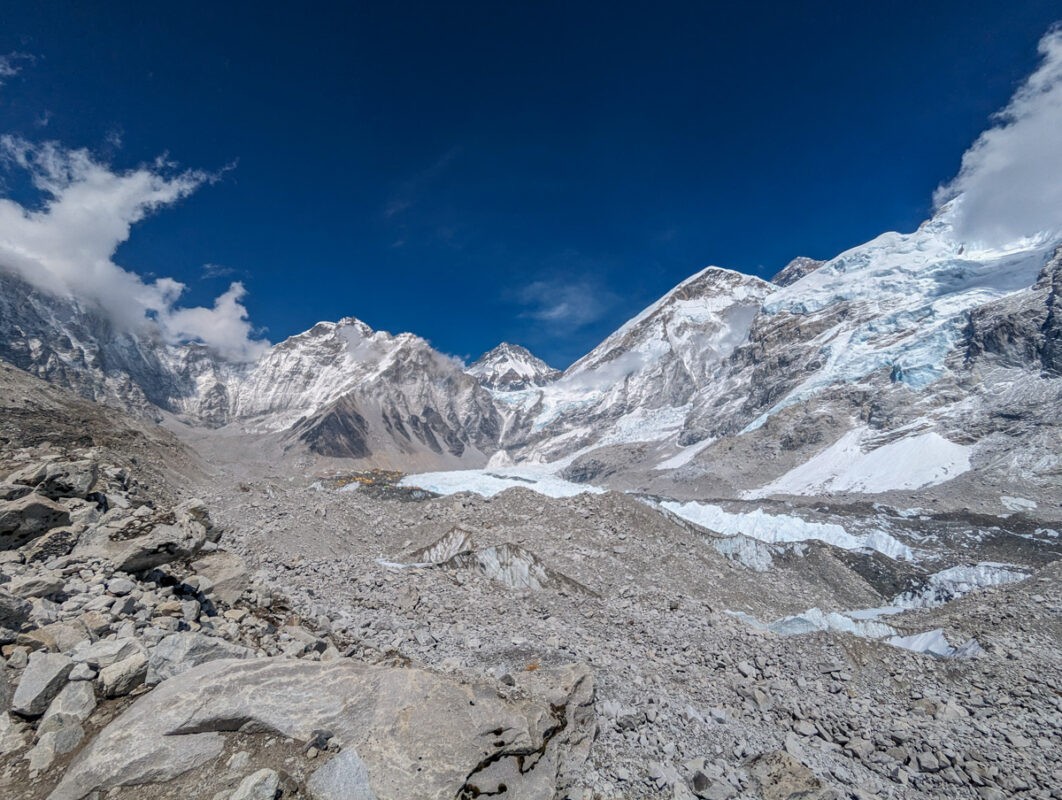
The single biggest danger on the Everest Base Camp hike is the altitude.
You’ll land at 2,800 metres in Lukla and hike up to 5,300 metres at Everest Base Camp.
It’s not as high as Everest summit, of course, but it’s still definitely high enough to make some people unwell!
It’s normal to feel a bit “off” at altitude, but it’s important to keep an eye on your symptoms to check they don’t develop into Acute Mountain Sickness (AMS). AMS can then develop into High Altitude Cerebral Edema (HACE) or High Altitude Pulmonary Edema (HAPE) which are both severe and life-threatening.
It is rare for tourists to base camp and below to develop such advanced AMS, but it can happen. In fact, when we were hiking Everest Base Camp, someone tragically died due to AMS (this wasn’t the incidence, but it’s another report from 2024)
They apparently lost their group and by the time they were found, they were coughing up blood and hallucinating. By the time they got heli-evacuated, it was too late, and they’d died before they reached the lower altitude at Lukla.
This is a rare case; apparently, an average of 2-3 tourists die every year on base camp (out of 40,000) and most of them are due to preventable altitude sickness.
So, it’s important to fully verse yourself on the condition and when you might need to seek medical assistance.
Minor altitude sickness symptoms include:
- Headache
- Dizziness
- Vomiting and nausea
If you experience any of these, it’s important to keep an eye on them and see how they improve. However, it is difficult sometimes to pinpoint these to altitude sickness, as they can be due to a variety of other reasons.
I had quite a few headaches on EBC (our guide told us that usually if they’re on the forehead, they’re ok but to worry a bit more if they were at the back of the head) and I was even sick one night (I was told because it was only once and then I felt much better, it was more likely to be food related).
More severe symptoms include hallucinations, severe shortness of breath, vomiting blood and acting erratically. At this stage, blood oxygen often drops too.
Here’s how to keep yourself safe from altitude sickness:
- Take it slow: The best way is to ascend slowly and don’t rush up hills.
- Diamox: Personally, I took Diamox and was glad I did. You can either purchase in your home country or Kathmandu, but do be aware that you can’t take it with some medications or underlying medical conditions – so if you have any, speak to your doctor.
- Keep track of your symptoms: The most important thing to do is to keep track of your symptoms, if you have a guide keep them updated with how you’re feeling, and seek help if you have any worsening symptoms. If you don’t have a guide, people at the tea house can help you.
One of our friends did get heli evacuated off the mountain (once he reached Lukla, he felt much better), and apparently, someone is in around 40% of trips, so it’s a very real possibility – but as long as you’re quick in doing so, your symptoms should improve when you go down.
None of this is medical advice – please consult websites like the NHS’s page on altitude sickness for official advice.
Travel insurance
This is a good time to stress that you need travel insurance for this trek.
Even if you don’t usually get it (in my opinion you should always be getting it, but that’s a story for another day), it’s essential for EBC.
The risk of needing heli evacuation is very real, even if you’re fit and healthy. It’s expensive to order a helicopter, so unless you want to pay a few thousand dollars, you’ll need insurance!
It’s also important to have the right travel insurance. I usually go with SafetyWing, but they didn’t cover trekking above 4500m and heli-evacuation. In the end, I went with True Traveller, who specialise in Everest Base Camp insurance.
Natural disasters
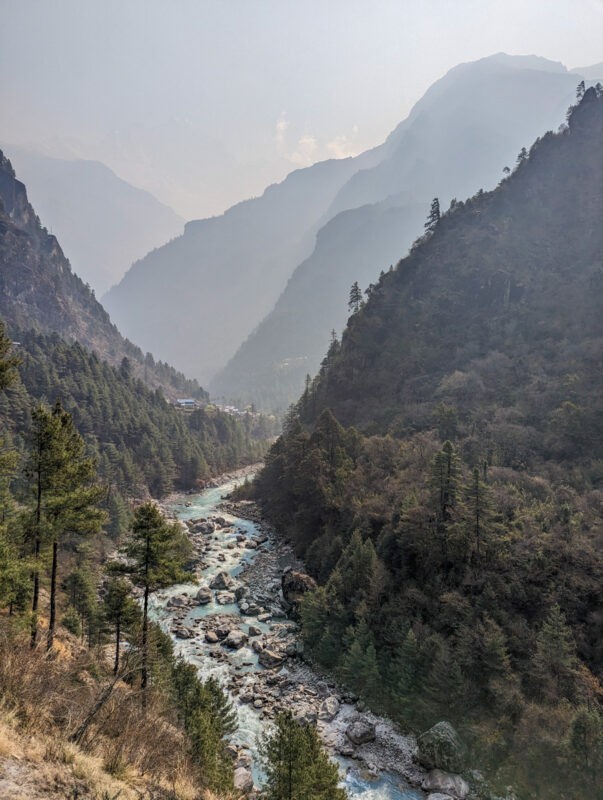
The Himalayas are stunning, but they come with their own set of natural challenges that can affect your trek – although they’re not likely to.
Firstly, let’s talk about earthquakes. Nepal sits on major fault lines, and the region can experience significant seismic activity. While it’s rare for tremors to occur precisely during your trek, it’s something to be aware of. In fact, I think I felt a small tremor one night!
In 2015, the major Nepal earthquake triggered avalanches and landslides in the region. This was the year that 22 people were killed at base camp in an avalanche. However, an earthquake on such a scale is rare in the region.
Landslides and avalanches, speaking of which, are also potential hazards, particularly if you’re trekking in the pre-monsoon season (April to June) or post-monsoon season (September to November).
The trails can be unstable, and heavy rainfall can increase the risk of landslides, cutting off routes and making some parts of the trail impassable.
The weather itself can be a formidable force. Sudden changes in weather are common, and snowstorms can occur, particularly as you reach higher elevations. A clear day can turn into a challenging scenario within hours – especially if you’re hiking without a guide.
So, how do you stay safe? Always check the local weather conditions and heed the advice of your guide—they know these mountains better than anyone. If you don’t have a guide, ask for advice at the tea houses.
Ensure you have the necessary gear for cold and wet weather, regardless of the season. Lastly, be flexible with your plans; sometimes waiting a day or two at a lower camp for conditions to improve is the safest decision.
Social safety
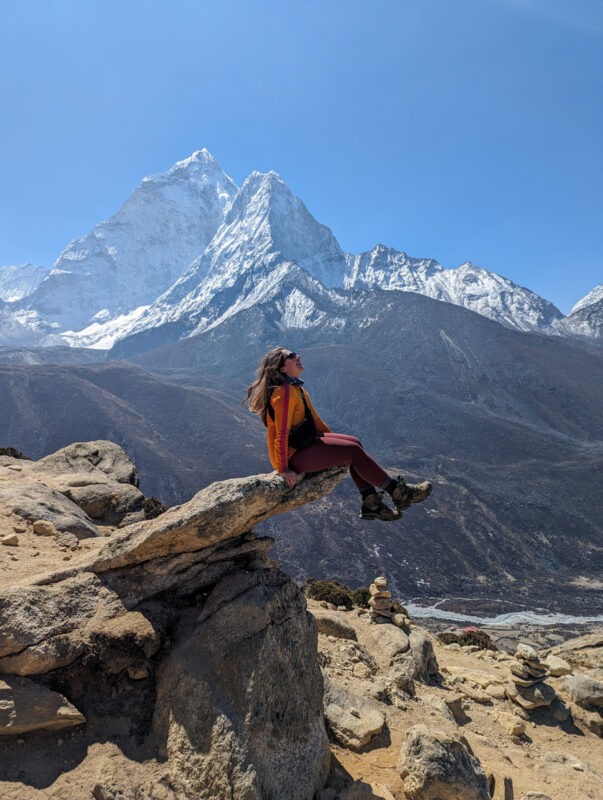
When it comes to social safety, the Everest Base Camp trek is generally considered very safe, – much more so than most of the world’s major cities!
The trekking community and the locals along the route are known for their hospitality and helpful nature.
Theft or violent crime is incredibly rare on the Everest trail. Both fellow trekkers and local Nepalese are usually focused on their journey or their work and there’s typically a mutual respect among trekkers and the local community.
Additionally, as you trek through various villages and communities, you’ll notice a strong sense of camaraderie. Local guides and porters are not only knowledgeable about the terrain but are also keen to ensure your safety and well-being. They’re your first line of defence against potential issues, and their guidance is invaluable!
However, like any travel experience, it’s wise to take standard safety precautions. Keep your belongings secure, don’t flash expensive equipment unnecessarily, and stay with your group.
It’s also a good idea to share your travel itinerary with someone back home and check in regularly.
Hiking safety
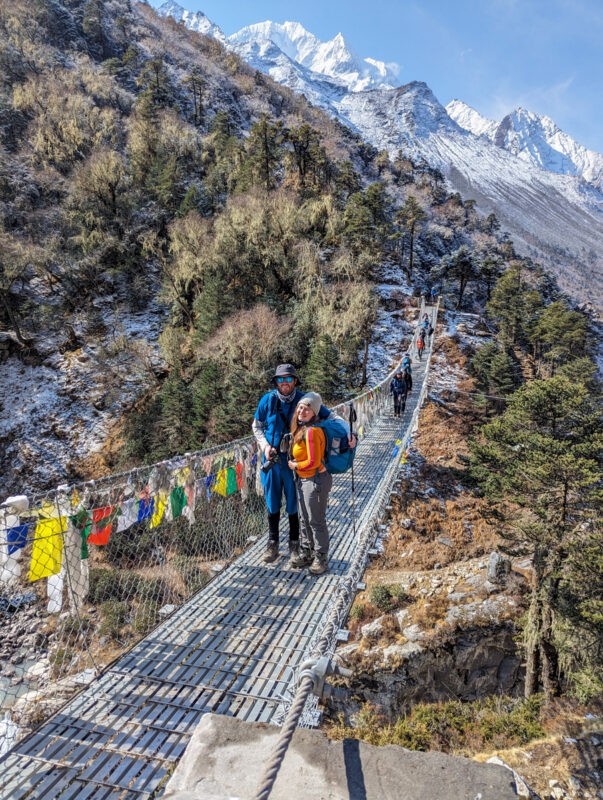
The path to Base Camp, while well-trodden, does have a few unique challenges!
One of the first things you’ll notice is that the trails can be narrow. While they are never dangerously so, there are sections where you’ll need to be cautious, especially when passing others or when large groups are trekking at the same time.
You’ll also be sharing these paths with donkeys, yaks and oxen, which are commonly used by the locals to transport goods up and down the route. These animals are generally well-behaved, but it’s wise to give them right of way and avoid startling them. Always pass on the uphill side as this helps prevent any accidents, should the animals get spooked and move unpredictably.
Another unique feature of the Everest trek are the suspension bridges.
These bridges, which span fast-flowing rivers, can be intimidating at first glance with their dramatic swings and sometimes crowded conditions. I didn’t love crossing them!
However, they are generally sturdy and safe.
Ensure you follow any posted instructions, hold onto the handrails, and don’t stop in the middle to take photos when there is heavy traffic.
The terrain itself can also be challenging. You’ll encounter everything from steep inclines to rocky descents, which can be slippery when wet.
Good quality, well-fitting hiking boots with strong ankle support and grip are essential to navigate these areas safely.
Plus, using trekking poles can help maintain balance and reduce strain on your knees during long descents.
Food and drink on the EBC trail
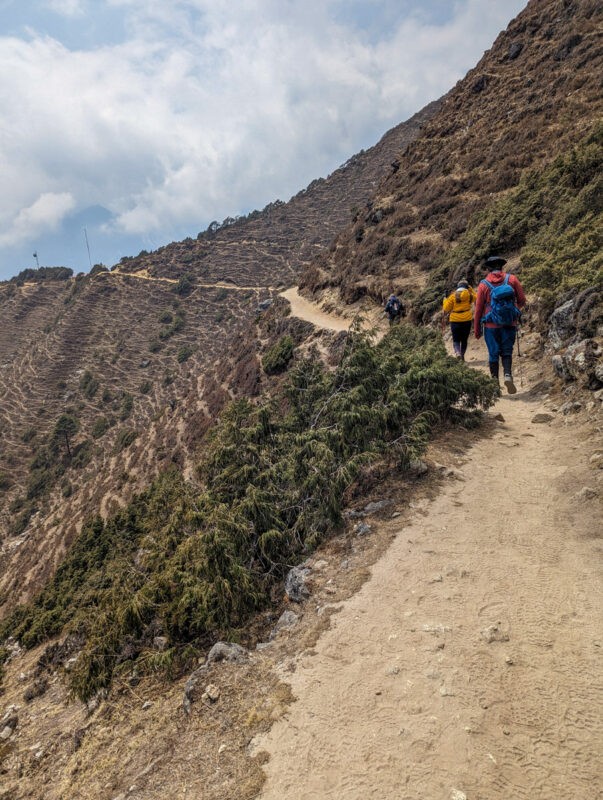
Food on the Everest Base Camp trail is…. Quite limited. You’ll be eating at tea houses, and while they may seem like they have an extensive menu at the start, pretty much all tea house has the same menu, each and every day!
It can get quite repetitive, and after I was poorly due to eating something bad, I was quite picky about what I ate on the menus, as I was worried about getting sick again.
Unfortunately, food sickness is relatively common on the trail, partially due to the adjustments your body has to make to both the altitude and the change in diet. A few of us were unwell.
To minimise risks, ensure that any food you consume is cooked thoroughly and served hot. Avoid raw vegetables and salads unless you are sure they have been washed in safe water.
One key tip is to avoid consuming meat during your trek. Since all meat has to be carried up the mountain, often without adequate refrigeration, it’s not always fresh by the time it reaches higher altitudes.
Sticking to vegetarian meals can significantly reduce the risk of foodborne illnesses. The local dal bhat (lentils and rice) is a safe, nutritious, and replenishing option that is freshly prepared and can be enjoyed hot. You get unlimited top ups of dahl baht too, which is wonderful!
Be cautious with packaged and processed foods. We found that many items might were past their expiration date due to the logistical challenges of restocking supplies in such remote locations.
Staying hydrated is crucial (our guide recommends four litres of water a day), but you must ensure that the water is safe to drink.
Drinking untreated water can lead to waterborne diseases, and while it’s cleaner in the mountains than in Kathmandu, it’s still not great for stomachs that aren’t used to it.
Always use water purification tablets or a reliable water filter. Bottled water is available but using reusable bottles with a purification method is more environmentally friendly and often more practical.
I always use Water to Go bottles when I travel and had it with me for my entire Everest Base Camp hike!
Tips for staying safe on the Everest Base Camp hike

- Hike with a Guide and Porter: You don’t have to hike with a guide or porter in the Everest region (you do elsewhere in Nepal), but I couldn’t imagine hiking without my guide. Not only did they know the route exceptionally well, but they also provided valuable insights into local customs and help with language barriers and helped us with altitude sickness issues.
- Get a Local SIM Card: Having a local SIM card ensures you stay connected with your group and can contact emergency services if necessary.
- Invest in Good Quality Gear: Ensure you have appropriate hiking boots, warm clothing, a sturdy backpack, and other necessary trekking equipment that’s suitable for harsh mountain conditions.
- Acclimatize Properly: Take your time to acclimatise to the altitude, with appropriate rest days scheduled into your trek to reduce the risk of altitude sickness. If you do a tour, these will be factored in.
- Stay on Marked Trails: Always stick to the marked paths and trails to avoid getting lost or accidentally wandering into dangerous areas.
- Keep Informed about Weather Conditions: Weather in the Himalayas can change rapidly. Stay updated on weather forecasts and plan your trekking days accordingly.
- Carry Essential Medications: Include altitude sickness medication, as recommended by your doctor, along with a basic first aid kit.
- Use Sun Protection: At high altitudes, the UV rays are stronger. Wear sunscreen, sunglasses, and a hat to protect yourself from sunburn.
- Maintain Hydration Levels: Drink plenty of water throughout the trek to stay hydrated – around four liters per day – but make sure it’s purified or treated.
- Attend a Pre-Trek Briefing: Participate in any briefings offered by your trekking company to understand the specific risks and safety practices related to your journey.
- Carry Emergency Contact Numbers: Have a list of emergency contacts, including local authorities, embassies, and tour operators readily available.
- Travel Insurance: Ensure you have comprehensive travel insurance that covers high-altitude trekking and medical evacuation. Your usual travel insurance provider will probably not provide this, so make sure that you organise it ahead of time. I went with True Traveller.
- Keep Emergency Snacks and Extra Layers: Always carry extra food and clothing in case the trek takes longer than expected due to weather or other delays.
So, is the Everest Base Camp trek safe?
All things considered, and as long as you take precautions, know the symptoms of AMS and hike responsibly, I think hiking to Everest Base Camp is safe.
